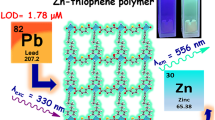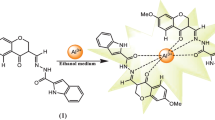Abstract
In this paper we reported a metal complex 1-Zn (2,5-di-[2-(3,5-bis(2-pyridylmethyl)amine-4-hydroxy-phenyl)-ethylene]-pyrazine-Zn) as a fluorescent probe sensing DNA. The result of the competitive experiment of the probe with ethidium bromide (EB) to bind DNA, absorption spectral change and polarization change in the presence and absence of DNA revealed that interaction between the probe and DNA was via intercalation. Ionic strength experiment showed the existence of electrostatic interaction as well. Scatchard plots also confirmed the combined binding modes. The fluorescence enhancement of the probe was ascribed to highly hydrophobic environment when it bound the macromolecules such as DNA, RNA or denatured DNA. The binding constant between the probe and DNA was estimated as 3.13 × 107 mol−1 L. The emission intensity increase was proportional to the concentration of DNA. Based on this, the probe was used to determine the concentration of calf thymus DNA (ct-DNA). The corresponding linear response ranged from 2.50 × 10−7 to 4.75 × 10−6 mol L−1, and detection limit was 1.93 × 10−8 mol L−1 for ct-DNA.







Similar content being viewed by others
References
Kumar CV, Asuncion EH (1993) DNA-binding studies and site-selective fluorescence sensitization of an anthryl probe. J Am Chem Soc 115:8547–8553
An Y, Lin YY, Wang H, Sun HZ, Tong ML, Ji LN, Mao ZW (2007) Cleavage of double-strand DNA by zinc complexes of dicationic 2,2'-dipyridyl derivatives. Dalton Trans 12:1250–1254
Kobayashi T, Tobita S, Kobayashi M, Imajyo T, Chikira M, Yashiro M, Fujii Y (2007) Effects of N-alkyl and ammonium groups on the hydrolytic cleavage of DNA with a Cu(II)TACH (1,3,5-triaminocyclohexane) complex. Speciation, kinetic, and DNA-binding studies for reaction mechanism. J Inorg Biochem 101:348–361
Chen B, Wu S, Li A, Liang F, Zhou X, Cao X, He Z (2006) Synthesis of some multi-beta-substituted cationic porphyrins and studies on their interaction with DNA. Tetrahedron 62:5487–5497
Wei CY, Jia GQ, Yuan JL, Feng ZC, Li C (2006) A spectroscopic study on the interactions of porphyrin with G-quadruplex DNAs. Biochem 45:6681–6691
Ghazaryan AA, Dalyan YB, Haroutiunian SG, Tikhomirova A, Taulier N, Wells JW, Chalikian TV (2006) Thermodynamics of interactions of water-soluble porphyrins with RNA duplexes. J Am Chem Soc 128:1914–1921
Bichenkova EV, Sardarian AR, Wilton AN, Bonnet P, Bryce RA, Douglas KT (2006) Exciplex fluorescence emission from simple organic intramolecular constructs in non-polar and highly polar media as model systems for DNA-assembled exciplex detectors. Org Biomo Chem 4:367–378
Udenfriend S, Zaltzman P (1962) Fluorescence characteristics of purines, pyrimidines, and their derivatives: measurement of guanine in nucleic acid hydrolyzates. Anal Biochem 3:49–59
Borresen HC (1963) On the luminescence properties of some purines and purim idines. Acta Chem Scand 17:921–929
LePecq JB, Paoletti C (1966) A new fluorometric method for RNA and DNA determination. Anal Biochem 17:100–107
Breslo JL, Crothers DM (1981) Equilibrium studies of ethidium–polynucleotide interactions. Biochem 20:3547–3553
Guo L, Qiu B, Chen G (2007) Synthesis and investigation on the interaction with calf thymusdeoxyribonucleic acid of a novel fluorescent probe 7-oxobenzo[b][1,10]phenanthroline -12(7H)-sulfonic acid. Anal Chimi Acta 588:123–130
Okamoto A, Ochi Y, Saito I (2005) Fluorometric sensing of the salt-induced B-Z DNA transition by combination of two pyrene-labeled nucleobases. Chem Commun 1128–1130
Okamoto A, Tainaka K, Nishiza K, Saito I (2005) Monitoring DNA structures by dual fluorescence of pyrene derivatives. J Am Chem Soc 127:13128–13129
Cao W, Ferrance JP, Demas J, Landers JP (2006) Quenching of the electrochemiluminescence of Tris(2,2′-bipyridine)ruthenium(II) by ferrocene and its potential application to quantitative DNA detection. J Am Chem Soc 128:7572–7578
Fürstenberg A, Julliard MD, Deligeorgiev TG, Gadjev NI, Vasilev AA, Vauthey E (2006) Ultrafast excited-state dynamics of DNA fluorescent intercalators: new insight into the fluorescence enhancement mechanism. J Am Chem Soc 128: 7661–7669
Zeglis BM, Barton JK (2006) A mismatch-selective bifunctional rhodium-oregon green conjugate: a fluorescent probe for mismatched DNA. J Am Chem Soc 128:5654–5655
Wu FY, Bae SW, Hong JI (2006) A selective fluorescent sensor for Pb(II) in water. Tetrahedron Lett 47:8851–8854
Long EC, Barton JK (1990) On demonstrating DNA intercalation. Accounts Chem Res 23:271–273
Lepecq JB, Paoletti C (1967) A fluorescent complex between ethidium bromide and nucleic acids: physical-chemical characterization. J Mol Biol 27:87–106
Scatchard G, Ann NY (1949) The attractions of proteins for small molecules and ions. Acad Sci 51:660–670
Lin HX, Bi QS, Peng H, Li ZL, Yu RQ (1992) Preliminary screening of some platinum and palladium complexes as antitumour agents using fluorimetry. Chem J Chinese Univ 13:443–446
Chien M, Grollman AP, Horwitz SB (1977) Bleomycin–DNA interactions: fluorescence and proton magnetic resonance studies. Biochem 16(16):3641–3647
Howe-Grant M, Wu KC, Bauer WR, Lippard SJ (1976) Binding of platinum and palladium metallointercalation reagents and antitumor drugs to closed and open DNAs. Biochem 15:4339–4346
Acknowledgments
Financial support of this study by the State Key Laboratory of Chemo/Biosensing and Chemometrics of Hunan University (No. 2005018), Jiangxi Province Education Ministry Foundation(No. 2005-38) and JXNSF (0420041) are highly acknowledged.
Author information
Authors and Affiliations
Corresponding authors
Rights and permissions
About this article
Cite this article
Wu, FY., Xie, FY., Wu, YM. et al. Interaction of a New Fluorescent Probe with DNA and its Use in Determination of DNA. J Fluoresc 18, 175–181 (2008). https://doi.org/10.1007/s10895-007-0261-6
Received:
Accepted:
Published:
Issue Date:
DOI: https://doi.org/10.1007/s10895-007-0261-6




